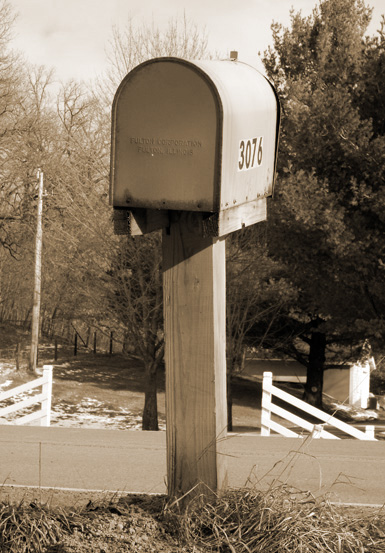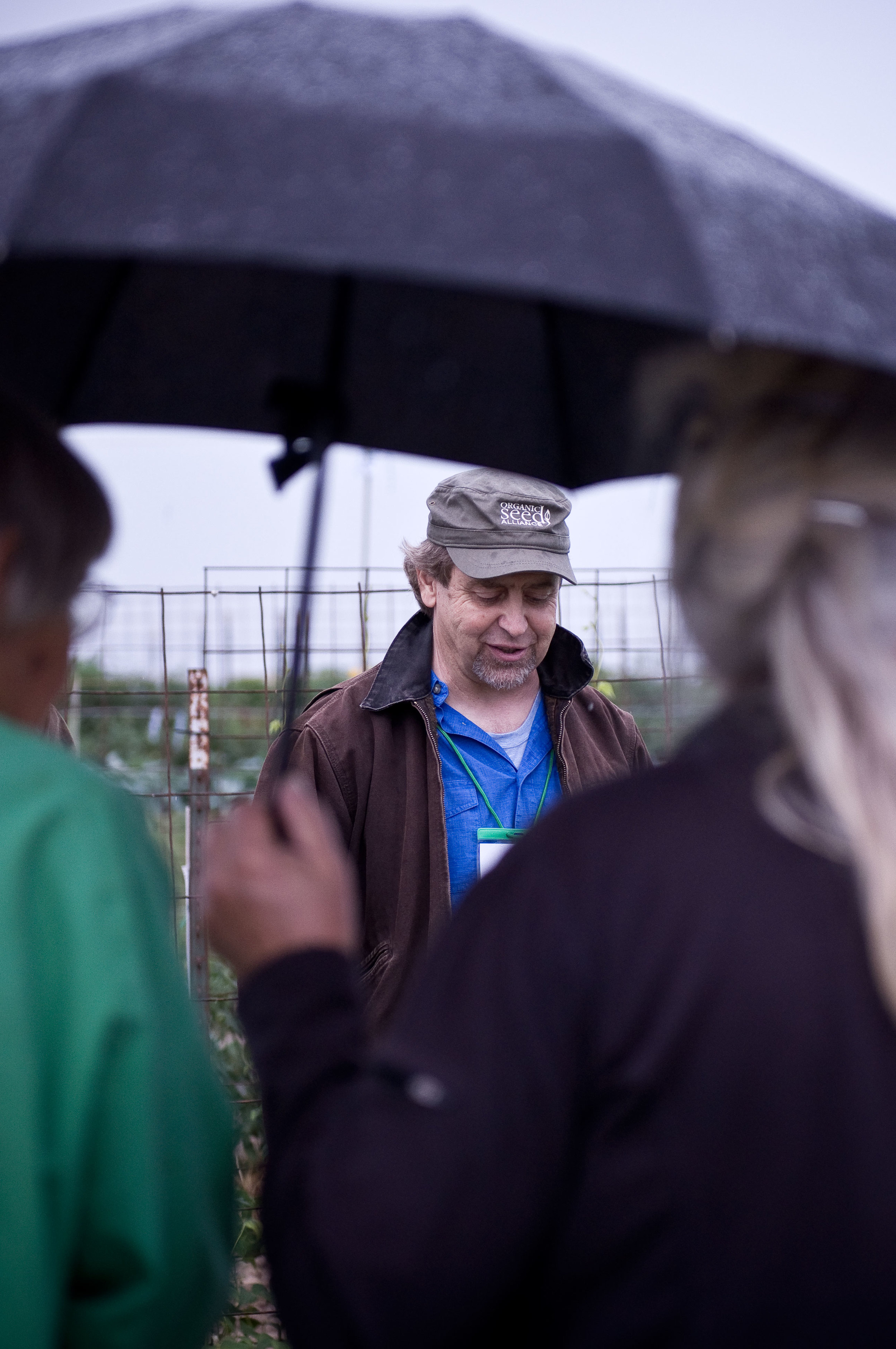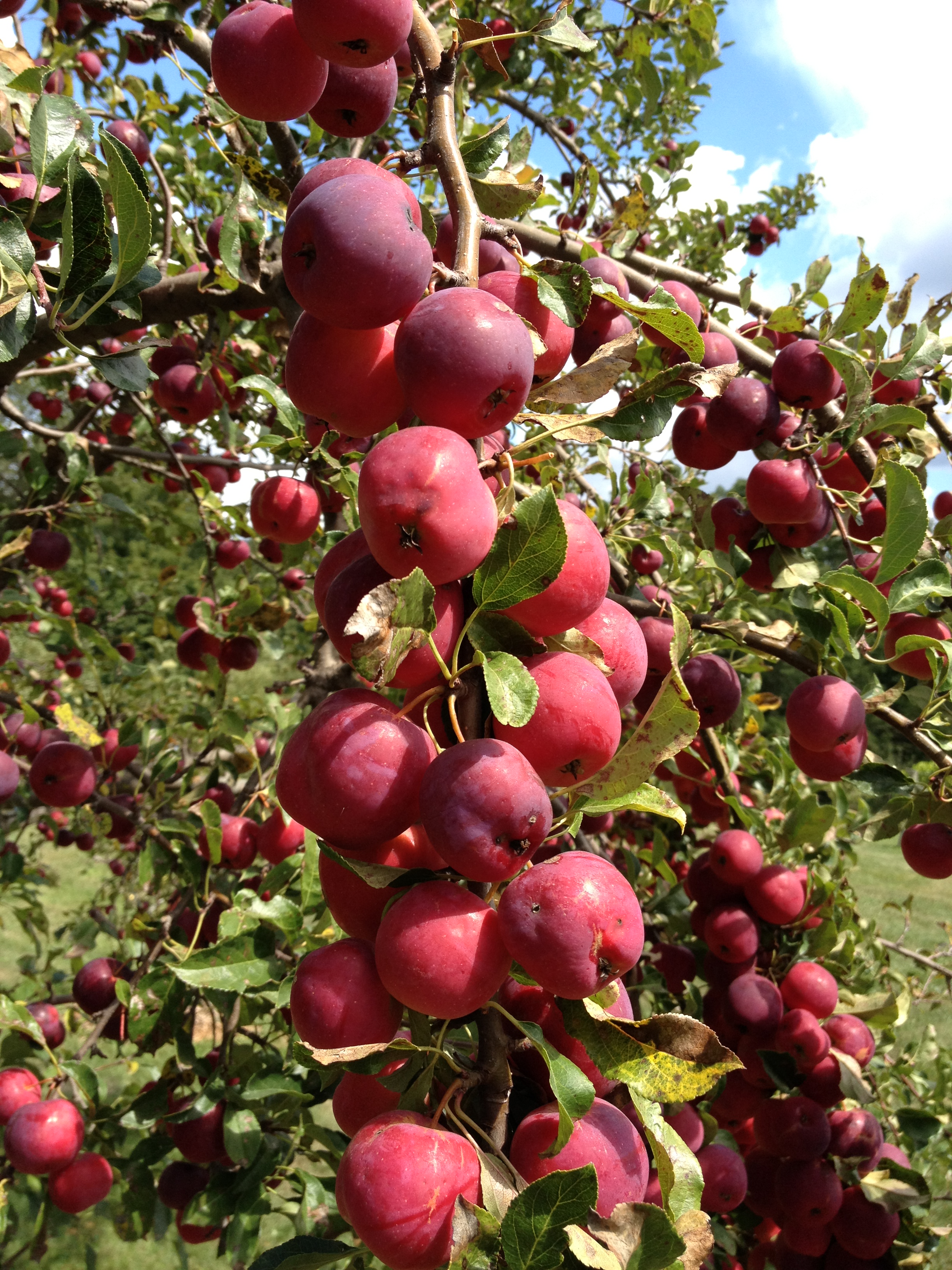This Valentine's Day, Say it With Seeds!
/Do you have a special someone to woo on this Valentine's Day?
Rather than the typical box of chocolates or bouquet of flowers, consider the gift that keeps on giving: Heirloom Seeds!
Read MoreDo you have a special someone to woo on this Valentine's Day?
Rather than the typical box of chocolates or bouquet of flowers, consider the gift that keeps on giving: Heirloom Seeds!
Read MoreThese days, speaking of a “mailbox” might bring about  images of our virtual mailboxes, not the charming metal containers at the end of our driveways. When Seed Savers Exchange began in the pre social media days of 1975, our members were older and living in rural parts of the country. They relied on these physical metal boxes to not only exchange hand-written letters but heirloom seeds as well. This unique club of seed savers referred to each other as “mailbox friends.”
This week our 2013 Yearbook will be mailed out to more than 10,000 members—the 38th year in a row—to continue facilitating this connection between seed saving brethren. This Yearbook might well represent the largest private index of seed varieties in the United States.
images of our virtual mailboxes, not the charming metal containers at the end of our driveways. When Seed Savers Exchange began in the pre social media days of 1975, our members were older and living in rural parts of the country. They relied on these physical metal boxes to not only exchange hand-written letters but heirloom seeds as well. This unique club of seed savers referred to each other as “mailbox friends.”
This week our 2013 Yearbook will be mailed out to more than 10,000 members—the 38th year in a row—to continue facilitating this connection between seed saving brethren. This Yearbook might well represent the largest private index of seed varieties in the United States.
While it is always a considerable challenge to compile the listings of more than 19,000 varieties from nearly 700 seed savers each year, one of the fun experiences is reading the many descriptions of varieties offered.
Passing by the office kitchen table on my way to get a cup of coffee a few weeks ago, two staff members were proofing the listings from the upcoming Yearbook and reading some of the anecdotes out loud. Christy was amused by an Iowa member who wrote, “In keeping with my penchant for selecting seed based on names (I buy wine the same way- don’t you?), ‘Little Brown Cat’ has joined my collection because, as my son observed, you really don’t see brown cats.”
Sarah said, “Listen to the history of the ‘Doloff’ bean.” First grown by Roy Dolloff in Vermont, he gave it to Hattie Gray who remembered walking with her mother to Burke Hollow and back to get the seed from him when she was a girl in the 1920’s. Hattie grew the seed for 60 years and gave it to Leigh Hurley who listed it in 1986. Today, 27 years later, five members are still listing the ‘Dollof’ bean.
Those hand-written letters are treasures which support Seed Savers Exchange’s belief that every seed has a story to tell. Whether you choose to utilize the yearbook as it always has been—through the print copy coming to your mailbox at the end of the driveway, or through the recently offered electronic version on our website, consider the people who have chosen to carry these varieties forward. Along with a check, send them a note of thanks in appreciation for preserving our garden heritage.
No matter the form of mailbox you use, we are thrilled to see Seed Savers Exchange members utilizing the Yearbook not only as a way to acquire and cultivate seeds, but relationships as well. As one member proudly told us this year, “In 2008 I contacted a SSE member in my area and we have been great friends ever since." Mailbox friends.
To learn more about the Yearbook and the additional benefits of becoming a SSE member, visit www.seedsavers.org/Membership/.
Decorah, IA. For the past 38 years, the Yearbook, which is distributed to Seed Savers Exchange’s 13,000 members, has grown into one of the largest private seed indexes in the United States. The Yearbook was created in 1975 in an effort to involve gardeners in the preservation of America’s garden heritage.
A non-profit grassroots organization, Seed Savers Exchange (SSE) asks its members, most of whom are home gardeners, to play a vital role as participatory conservationists in collecting, maintaining and sharing heirloom and open-pollinated seeds. Unlike hybrid seeds, the seeds of heirloom and open-pollinated varieties can be saved and grown again and will produce fruit true to the parent plant, a process used for thousands of years. The annual Yearbook is the preservation tool that fosters the sharing of seeds between SSE members.
“The Yearbook first started out as a mimeographed list of seeds shared by a handful of Seed Savers Exchange supporters back in 1975,” recalled Diane Ott Whealy, co-founder and Vice President of SSE. “Today, it is a 500 page compilation with almost 20,000 listings, ranging from Amaranth to Watermelon.”
This year SSE members have the opportunity to choose from 12,495 unique varieties from 694 listed members found across all 50 states and 12 countries. A listed member is a gardener or farmer who saves seed and offers them for exchange in the Yearbook. Each of these listed members provides an answer to what varieties perform well in their specific location: ‘Luther Hill’ corn in Ontario, ‘Speckled Butter’ bean in Mississippi, ‘Wenk’s Yellow Hots’ pepper in California, ‘Green Nutmeg’ muskmelon in Indiana, to name a few. Each variety offered in the Yearbook provides a connection between seed saver and grower.
“With the potential for climate change, the genetic variability of heirloom and open pollinated seeds has never been more important to safeguarding our future,” Whealy noted. “And the role the Yearbook and the Exchange plays is critical to providing alternatives for gardeners in an ever changing environment.” Learn more about the Yearbook and becoming a Seed Savers Exchange member here.
Located six miles north of Decorah, Seed Savers Exchange is a non-profit membership organization dedicated to the preservation and distribution of heirloom seeds. Seed Savers Exchange maintains a collection of thousands of open-pollinated varieties, making it one of the largest non-governmental seed banks in the United States. For information visit www.seedsavers.org.
For More Information, Contact:
Steve Carlson Seed Savers Exchange 563-387-5686 newsroom@seedsavers.org

Maintaining and distributing unique heirloom and open-pollinated seeds is the primary goal of the Seed Savers Exchange (SSE) gene bank. The Evaluation Program is an important link between maintaining varieties at Heritage Farm and getting them into the hands of gardeners, chefs, and farmers.
The Evaluation Program, which is only three years old, was started with the financial support from people like you. The program allows us to collect data on a variety’s traits throughout its life cycle. This data includes characteristics such as plant height, flower color, days to maturity, and fruit size.
The program also evaluates culinary usage—incredibly important in a world of unsustainable eating and forgotten food cultures. Modern fruits and vegetables bred for shipping and uniformity lack the diversity seen in heirloom varieties—like beets, potatoes, cabbages, and apples that store for months in a root cellar; horticultural beans harvested between the snap and dry bean phases for their higher protein content; and melons best suited for baking. The forgotten traits in these varieties are the building blocks to a sustainable food system.
The information collected through the evaluation program serves several purposes. It allows us to:
For the first time ever, Seed Savers Exchange is offering a collection of varieties ‘From the Preservation Gardens’ in our catalog this year. These varieties were selected because of their interesting histories, unique characteristics, and popularity with staff—a direct result of the Evaluation Program.
 A tax-deductible donation to Seed Savers Exchange will help us continue to maintain genetic diversity through projects like the Evaluation Program. Support our effort by making a donation or becoming a member online today, or call us at (563) 382-5990 (M-F, 8:30 am – 5:00 pm Central Time).
A tax-deductible donation to Seed Savers Exchange will help us continue to maintain genetic diversity through projects like the Evaluation Program. Support our effort by making a donation or becoming a member online today, or call us at (563) 382-5990 (M-F, 8:30 am – 5:00 pm Central Time).
Thank you for your support,
John Torgrimson Executive Director

P.S. Donate $150 or more before December 31, 2012 and receive a free Seed Savers Exchange 2013 Calendar, which offers a beautiful glimpse of nature's seed bounty at Heritage Farm near Decorah, Iowa, where every seed has a story to tell.
Eating beans from the pod, when the beans are fully expanded but not yet dry, is becoming a lost culinary tradition in America. The plump, wet, beans do not store well, and they are difficult to shell mechanically because the tender beans cannot tolerate rough handling. For these reasons, shelling beans have been shunned by industrial agriculture. However, the flavor is rich and shelling beans are richer in nutrients than dry beans. We added a horticultural bean taste test to our 2012 bean evaluation and found that most beans taste good as shelling beans, and some taste really good! Many that performed well in our taste test were not necessarily known as shelling beans historically. For example, “Bessie” (Bean 6042) has been passed down maternally in Frances Sullivan’s family for over a century, each generation using it primarily as a green bean for fresh eating and canning.

This variety really caught our attention in the 2012 taste test. We described it as having “excellent robust flavor, sweet and slightly tart, low-medium acidity, firm and meaty texture but still juicy, great as a slicing tomato.” Curious about the variety, we investigated its history and discovered that it is mis-named in our collection and should be called “Djena Lee’s Golden Girl.” We are not the first to notice its outstanding flavor. It is promoted by Slow Food USA’s Ark of Taste, and won the Chicago Fair’s taste test 10 years in a row in the 1920s and 1930s. Though historically, women played a central role in developing and improving varieties in America’s gardens, Djena Lee was one of the few female plant breeders who enjoyed recognition for her efforts in early 20th century America.

Most kohlrabi reach market maturity in 50-60 days and quickly become woody if left in the field. For that reason, we complete our market mature evaluation at 60 days. One variety in our evaluation grow-out, ‘Giant Czechoslovakian,’ did not form a kohlrabi head at 60 days. We thought it did not care for the spring weather. But in our fall grow-out of the same varieties, it again produced no stem-swelling at 60 days. We began to question whether it was really a kohlrabi, or if our seed-stock was compromised by crossing with another Brassica oleracea. We researched similarly named varieties in commercial catalogs, promoted as a 130 day maturity kohlrabi that does not get woody even when large. Then we went back to the long-forgotten spring planting and found enormous kohlrabis! Harvested at 176 days, they tasted great!
This squash’s oblong shape, size, and dark green mature color make it look somewhat like a cucumber. A staff favorite as a winter squash, this year we evaluated this pepo squash as a summer squash as well. To our surprise, ‘Dostal’ turned out to be a favorite 2012 summer squash - with its dense flesh and mildly sweet flavor. It went on to win accolades again in the 2012 winter squash taste evaluation for its buttery, smooth texture and complex, rich flavor. ‘Dostal’ has proven that we cannot make assumptions about the versatile varieties in our collection based on the limitations of more modern, highly specialized varieties.

At the Seed Savers Exchange Conference this summer, Dr. John Navazio 's talk, "Debunking the Hybrid Myth," laid out the hybrid vs. open-pollinated argument. Here's a peek at John's speech, the whole speech is available here. Also, check out Dr. Navazio's new book, The Organic Seed Grower, due out in December.

Why are hybrids favored?
What are the disadvantages of hybrids?
What are the advantages of open-pollinated varieties?
What are the disadvantages of OP’s?
Looking to increase the number of oohs and aahs you receive this Thanksgiving? Try going the homemade heirloom route by using winter squash instead of canned pumpkin in your pumpkin pies. One of the very best varieties for making pies is Winter Luxury, and we've got just the recipe for you!
Read MoreThis year's Harvest Festival was filled with presentations and workshops from SSE staff as well as two guest speakers presenting as part of our Harvest Lecture Series. Dan Carmody, president of the Detroit Eastern Market, spoke in the final hour of the event, describing the history and future of Detroit, the market, and the larger narrative of regionally-based food systems. Dan's presentation discusses issues with current food systems (energy use, nutrition, subsidies, distribution) as well as strategies for reform. Using the Eastern Market as an example, he describes the potential for local food systems to bring about transformative economic, social, and ecological change - particularly in urban areas.
The audio below contains the entirety of Dan's lecture: from Detroit's long decline to its recent rebirth; from the surging community gardening movement to the rebuilding of a local food processing infrastructure.
The Great Famine, Green Acres and Detroit
[audio: http://blog.seedsavers.org/wp-content/uploads/2012/10/dc01greenacresanddetroit.mp3]
An Effect Greater Than Carpet Bombing
[audio: http://blog.seedsavers.org/wp-content/uploads/2012/10/dc02aneffectgreaterthancarpetbombing.mp3]
This Narrative of Rebirth and Detroit Eastern Market
[audio: http://blog.seedsavers.org/wp-content/uploads/2012/10/dc03thisnarrativeofrebirth.mp3]
Offering Food and Conviviality, Food Systems and Energy
[audio: http://blog.seedsavers.org/wp-content/uploads/2012/10/dc04sellingfoodandconviviality.mp3]
A Host of Problems, Favorite Dichotomies and Local Food Production
[audio: http://blog.seedsavers.org/wp-content/uploads/2012/10/dc05ahostofproblems.mp3]
Department of Defense and Rebuilding a Regional-Based Food System
[audio: http://blog.seedsavers.org/wp-content/uploads/2012/10/dc06rebuildingregionalfoodsystems.mp3]
The Community Gardening Movement and Our Future Food Systems (Excluding Underwater Cities of Tomorrow)
[audio: http://blog.seedsavers.org/wp-content/uploads/2012/10/dc07ourfuturefoodsystems.mp3]
Eastern Market Capital Plan, Pickles and Custard Pie
[audio: http://blog.seedsavers.org/wp-content/uploads/2012/10/dc08ourcapitalplan.mp3]
$20 Million Worth of Meat and Pieces of the Food System
[audio: http://blog.seedsavers.org/wp-content/uploads/2012/10/dc09piecesofthefoodsystem.mp3]
Graffiti, Bloody-Run Creek, Food Access and Engagement
[audio: http://blog.seedsavers.org/wp-content/uploads/2012/10/dc10graffitiandfoodaccess.mp3]
This Country Deserves More Than Two Hams and How We Feed Cities
[audio: http://blog.seedsavers.org/wp-content/uploads/2012/10/dc11howwefeedcities.mp3]
Food and Local Economies, Craft Beer and Furgency
[audio: http://blog.seedsavers.org/wp-content/uploads/2012/10/dc12foodandlocaleconomies.mp3]
Lectures were supported by a grant from the Leopold Center for Sustainable Agriculture
(Johnston, Iowa) -- Market to Market, the weekly journal of rural America, will include a story about Seed Savers Exchange and the River Root Farm in its October 26, 2012 edition of the series.
The story features Decorah, Iowa-based Seed Savers Exchange, a nonprofit seed bank that maintains thousands of heirloom vegetables, herbs, flowers, and plants. One of the nation’s largest non-governmental seed banks, Seed Savers Exchange carries heirloom varieties that have been passed down through generations of farmers and gardeners. These varieties are valued for their genetic diversity and adaptability to pressures such as climate change.
Seed Savers Exchange seeks to preserve and share agricultural heritage with its membership and the public. The Millennium Seed Bank Partnership estimates that about 25 percent of all plants are in danger of becoming extinct.
“We believe strongly that given the changes that are occurring with weather and climate, regional differences, that it’s really important that all seeds be maintained for future generations,” said John Torgrimson, president and executive director of Seed Savers Exchange. “A hundred years from now we might not know what seeds in our seed bank are best adaptable to the conditions that might exist…here in Decorah, Iowa.”
Market to Market also talked to Mike Bollinger and Katie Prochaska of the River Root Farm, a diversified vegetable and seed farm located near Decorah. River Root Farm grows garlic with seed stock from Seed Savers, and provides the organization with garlic for retail sale.
Market to Market is produced by Iowa Public Television and broadcast in 20 states on more than 114 public television stations. Hosted by Mike Pearson, Market to Market covers the $100+ billion business of food, and issues affecting the 56 million residents of rural America.
In Iowa, Market to Market can be seen at 8:30 p.m. Friday, October 26, and again at 1 p.m. on Sunday, October 28. This week’s broadcast times reflect a temporary schedule change due to political coverage on IPTV.
Market to Market can also be seen online beginning Friday evening at www.iptv.org/mtom. Additional analysis from Market to Market experts is also available on this website.
For more information about Market to Market, contact Iowa Public Television at 515-242-3146.
Information on programming channels, reception, and more can be found at www.iptv.org.
Despite the gloomy weather, Harvest Festival was a cozy event under the post and beams of Heritage Farm’s old barn. Nearly 300 attendees sampled dozens of different antique apple varieties, heirloom beans, and fragrant roasted garlic. Tasting over 26 varieties of apples in one place was truly a unique experience. Apple expert Dan Bussey commented, “I am always amazed that there is no one favorite apple, some visitors really didn’t like Black Gilliflower, one of my favorites. Taste is so subjective, just another reason this diversity is so important.”

Area chefs Jim McCaffrey from McCaffrey’s Dolce Vita, Justin Scardina from La Rana, Mattias Kriemelmeyer from the Oneota Community Coop, and Stephen Larson from Quarter/QUARTER, went head to head in a soup cook-off featuring heirloom garlic varieties. Chef Stephen Larson from Quarter/QUARTER was this winner. Check out his winning recipe, or better yet, head over to his restaurant.
Garlic Insanity!!!
©Stephen Larson and QUARTER/quarter Restaurant LLC
Makes about 10 – 12 ounce servings
For the soup:
Directions: Melt the butter in a large soup pot over low heat. Add the garlic then cook it over VERY LOW heat, stirring occasionally, until very lightly golden (about 1 hour). Meanwhile, trim the stems from the oyster mushrooms and reserve. Set aside 6 ounces of the mushroom caps for the garnish then add the rest of the caps to the reserved stems. Once the garlic is done cooking, add the reserved mushrooms stems and cap mixture, 1 1/2 pounds of the corn kernels, salt, sugar, pepper sauce and stock to the soup pot and bring to a boil over high heat. Once it has come to a boil, turn the heat down to medium and simmer for 20 minutes (or until the potatoes are very soft). Meanwhile, make the garnish. When the soup is done simmering, stir in the cream and cheese then blend in batches on high speed until smooth, passing each batch though a fine strainer, to remove the corn skins, into another pot. Continue below to finish.
For the garnish and to finish the dish:
Directions: Put the butter into a large skillet over high heat. When the butter is melted, add the mushrooms and rosemary, and continue to cook over high heat until the mushrooms are lightly colored. Add the corn and continue to cook until just tender. Stir into the blended soup and serve hot.
Or try this one from Chef Jim McCaffrey:
Roasted Garlic, Braebern Apple, Sharp Cheddar Cheese Soup
Directions
Preheat oven to 350 degrees. Cut tip end of garlic off. Rub open garlic in kosher salt and sprinkle with olive oil. Wrap with aluminum foil and bake in oven for forty five minutes. Take cloves out of paper. Add ¼ cup olive oil to large sauté pan. Saute celery, onions, and carrots until carrots are soft. Add flour and stir it in until slightly browned. Add garlic cloves. Puree in food processor. Add to large pot. Add two tbl olive oil to sauté pan and sauté apples until soft. Puree and add to pot. Add broth and bring to a gentle boil. Turn heat to low and add cream and cheese. When cheese is melted, add remaining ingredients and stir. Enjoy!
 If you love apples, then you won’t want to miss the Harvest Festival at Seed Savers Exchange on Saturday, October 13, 10:00 am – 4:00 pm. Come learn that there is more to American apple diversity than Red Delicious and all her modern cousins.
If you love apples, then you won’t want to miss the Harvest Festival at Seed Savers Exchange on Saturday, October 13, 10:00 am – 4:00 pm. Come learn that there is more to American apple diversity than Red Delicious and all her modern cousins.
Bring your seeds saved from this year’s harvest for the seed swap. Sample antique apple varieties and vote in the Harvest Soup Cook-off featuring area chefs from La Rana, McCaffrey’s Dolce Vita, Oneota Community Food Cooperative, and QUARTER/quarter.
Other events taking place at the Seed Savers Exchange Harvest Festival—tours, seed swap, apple pressing, and hayrides—begin at noon. Children’s activities—squash squisher, pumpkin carving & seed saving, seed packet making and collecting, pillow sack threshing, and a garden scavenger hunt—will be happening all day.
Harvest Lecture Series
This year Seed Savers Exchange presents several lectures, including two speakers who are devoted to using healthy food as a tool for developing communities.
 1:00pm Emily Torgrimson—“Sponsoring community meals to support charitable organizations.” Torgrimson is founder of Eat for Equity, a non-profit that stages community meals and uses the donations to fund the work of charitable organizations. Featured on the TODAY Show, Eat for Equity has branches in Minneapolis, Boston, Portland, Washington D.C. and Phoenix.
1:00pm Emily Torgrimson—“Sponsoring community meals to support charitable organizations.” Torgrimson is founder of Eat for Equity, a non-profit that stages community meals and uses the donations to fund the work of charitable organizations. Featured on the TODAY Show, Eat for Equity has branches in Minneapolis, Boston, Portland, Washington D.C. and Phoenix. 3:00 pm Dan Carmody—"Developing Regional Food Systems." Carmody is the President of the Eastern Market Corporation, Detroit, Michigan, where he leads the non-profit charged with converting one of the nation’s oldest and largest public markets into the nation’s most comprehensive healthy metropolitan food hub.
3:00 pm Dan Carmody—"Developing Regional Food Systems." Carmody is the President of the Eastern Market Corporation, Detroit, Michigan, where he leads the non-profit charged with converting one of the nation’s oldest and largest public markets into the nation’s most comprehensive healthy metropolitan food hub.Seed Saving Workshop
For the garden enthusiast, a full-day workshop on the fundamentals of seed saving will be held on Sunday, October 14, from 10:00 am - 4:00 pm. This includes an introduction to seed saving, saving biennials, wet and dry processing and storing seeds. Participants will get hands-on seed saving experience. Preregistration is required. Cost is $40 and includes a box lunch (Seed Savers Exchange members receive a 10% discount). Register here.
Located six miles north of Decorah, Seed Savers Exchange is a non-profit membership organization dedicated to the preservation and distribution of heirloom seeds. Seed Savers Exchange maintains a collection of thousands of open pollinated varieties, making it one of the largest non-governmental seed banks in the United States. For information visit www.seedsavers.org.
For more information contact:
Shannon Carmody Seed Savers Exchange shannon@seedsavers.org 563-387-5630
Seed Savers Exchange is a nonprofit, member supported organization that collects, preserves and shares heirloom seeds for our future. Since 1975, SSE and our supporters have collected the seeds and stories that would otherwise have been lost.











Seed Savers Exchange is a tax-exempt 501(c)3 nonprofit organization dedicated to the preservation of heirloom seeds.
Seed Savers Exchange
3094 North Winn Road
Decorah, Iowa 52101
Send Us A Message
(563) 382-5990
Customer Service Hours:
Monday to Friday, 9am - 5pm CST
© 2020 Seed Savers Exchange